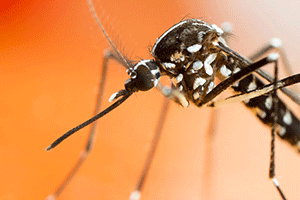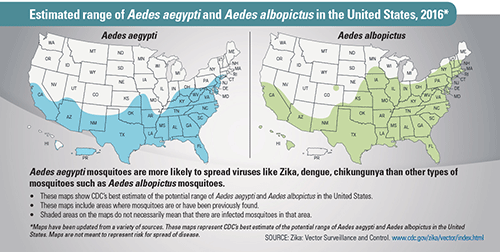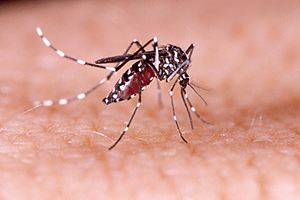 |
There is a significant new development regarding the potential spread northward of the Zika virus with implications for large portions of the United States. For the first time, according to the Pan American Health Organization (PAHO), the Zika virus has been found in a species of mosquito other than the Aedes aegypti mosquito.
According to PAHO, a branch of the World Health Organization, Zika virus was discovered in a batch of Aedes albopictus mosquitoes collected in the Mexican province of San Luis Potosi. This is the first time in the Western Hemisphere that the Aedes albopictus, commonly called the Asian tiger mosquito, has been identified as a vector species for Zika virus disease.
This is highly significant because many U.S. public officials have assumed that if the Zika virus does spread to the U.S., it would likely only be within the present range of the Aedes aegypti mosquito, now found most commonly in Florida, the coastal south and along the Gulf Coast states. The new findings implicating Aedes albopictus mean that the potential range of mosquitoes that could transmit the Zika virus could be much further north than previously thought. Aedes albopictus is now found in most states in the east and the New England region, west to the Midwest, and north to the lower Great Lakes region. States and localities that assumed they would not be affected by Zika must now consider how they should respond to the potential expansion of Zika. CDC is strongly recommending these states take the threat of Zika seriously and ramp up public education and control plans.
 |
Of additional concern is that the habits of the Aedes albopictus are much different than the Aedes aegypti mosquito. Aedes aegypti, sometimes known as the ‘urban mosquito, prefers dark damp locations and breeds in small containers of stagnant water. Aedes albopictus, on the other hand, lives more often in undeveloped areas, laying its eggs in natural pools of water as well as man-made containers. It can be most commonly found in yards, gardens, turf areas and parks. Aedes albopictus is a more aggressive species than Aedes aegyptus, seeking a blood meal from humans and other mammals any time of the day.
The European Centre for Disease Prevention and Control (ECDC) has called Aedes albopictus, the Asian tiger mosquito, the most invasive mosquito species in the world. ECDC says the species “is undergoing a dramatic global expansion facilitated by human activities,” and that due to climate change conditions, may spread beyond its present geographical boundaries into colder climates.
What this means to park and recreation agencies is still an evolving challenge. Following the lead of park and recreation agencies in Florida and along the Gulf Coast that are on the front lines of anticipating the spread of Zika, it is clear that gaining better knowledge of the habits and breeding cycles of these mosquitoes along with awareness of their presence within your parks is of paramount importance.
 |
With the discovery of Aedes albopictus as a new vector species for Zika, the potential range of this disease is suddenly much greater than had been previously thought. In addition, the strategies for control of the Aedes albopictus are decidedly different than those for control of Aedes aegyptus.
Educating park and recreation staff and reaching out to public health and mosquito control agency counterparts will give you the knowledge to understand the threat and how you can help protect your staff and the public, particularly women of child-bearing age, from possible exposure to this disease.
Parks and recreation can play an important role in the coordinated response to the spread of Zika virus disease. See also “Zika and Parks: What You Need to Know” in the May 2016 issue of Parks and Recreation magazine. NRPA will continue to provide information and updates to this emerging public health threat.
Richard J. Dolesh is NRPA's Vice-President of Conservation and Parks.

